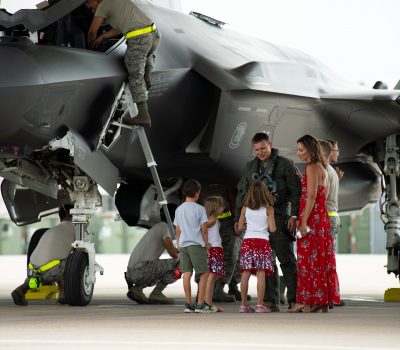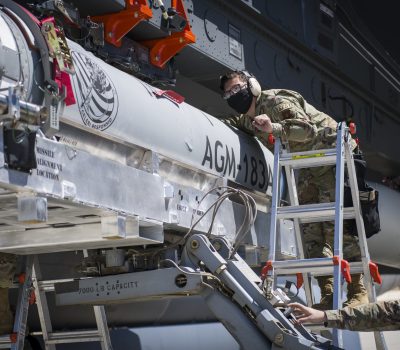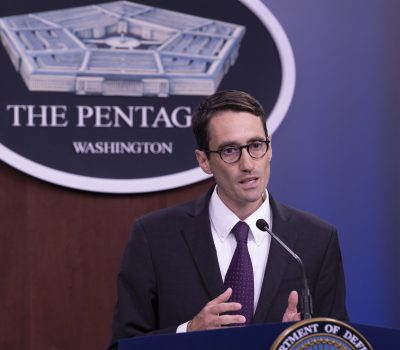Air Force Assesses Education Quality, License Portability Near USAF Installations
Hypersonic ARRW Wraps Early Testing Phase
DOD Space Policy Boss to Depart Aug. 21
The Air Force Challenged Hackers to Break into a DOD Satellite
Virtual Events: Scowcroft Group’s Miller on Mitchell’s Nuclear Deterrence Series, and More
Radar Sweep
Snapshot: DOD and COVID-19
Here's a look at how the Defense Department is being impacted by and responding to the COVID-19 pandemic.
Esper Says US Troop Presence in Afghanistan Will Be ‘Less than 5,000’ by November
Defense Secretary Mark T. Esper said in an interview broadcast late Aug. 8 that no more than 5,000 U.S. troops would remain in Afghanistan by the end of November as the Trump administration looks to move forward with a reduction of forces in the region.
Russia Warns It Will See Any Incoming Missile as Nuclear
Russia will perceive any ballistic missile launched at its territory as a nuclear attack that warrants a nuclear retaliation, the military warned in an article published Aug. 7. The harsh warning in the official military newspaper Krasnaya Zvezda (Red Star) is directed at the United States, which has worked to develop long-range non-nuclear weapons.
Alaska-Based Long-Range Ballistic Missile Defense Radar Fielding Delayed by a Year
The fielding of a U.S. Air Force radar to detect ballistic missile threats, currently being installed at Clear Air Force Station, Alaska, is delayed by roughly a year, according to a recent Government Accountability Office report. Information provided by the Missile Defense Agency in June to the GAO indicated all construction and integration activities for the Long Range Discrimination Radar had stopped in March due to the coronavirus pandemic.
Pentagon Updates Electronic Warfare Handbook with New Cross-Branch Approach
The U.S. military has updated its handbook on electronic warfare, changing it to a more all-encompassing, cross-branch approach for planning, executing, and assessing operations on the electromagnetic spectrum. The document, which is dated May 2020 but was not made public until late July, eliminates and replaces the previous joint publication for electronic warfare and provides principles and guidance related to joint electromagnetic spectrum operations, or JEMSO.
Retiring CMSAF Wright Talks Candidly about the Future of the Air Force, His George Floyd Post, and ‘Enlisted Jesus’ Memes
When Chief Master Sergeant of the Air Force Kaleth O. Wright retires after 31 years of service, he will leave as one of the most consequential chief master sergeants of the Air Force. Not only did he lead the way on the diversity issue, but Wright also helped push the Air Force to do more on suicide prevention and improving Airmen’s emotional resiliency.
White House Agrees to Cover All Costs for Guard Coronavirus Missions for Three More States
White House officials agreed to cover all of the costs of National Guard coronavirus response missions for three additional states on Friday, signaling that the federal government may eventually do the same for more states in coming months.
OPINION: Modernize the National Guard’s State Partnership Program
“Low-key deployments by citizen-soldiers have strengthened ties with 89 nations—but some crucial partners are missing,” write Bradley Bowman, senior director of the Center on Military and Political Power at the Foundation for Defense of Democracies, and Maj. Thomas G. Pledger, a visiting military analyst there.
Nagasaki Urges Nuke Ban on 75th Anniversary of US A-Bombing
The Japanese city of Nagasaki on Aug. 9 marked its 75th anniversary of the U.S. atomic bombing, with the mayor and dwindling survivors urging world leaders, including their own, to do more for a nuclear weapons ban.
DOD to Assess Female Troops' Reproductive Health for First Time in Decades
The Pentagon is conducting its first survey in more than 30 years specifically focused on the reproductive health of female service members, according to an Aug. 4 release from the Military Health System Communications Office. It begins this month.
VA Restarts Electronic Health Record Rollout
The initial deployment at a Spokane, Wash., medical center is now scheduled for October, while the new scheduling system will begin rolling out in August.
This Navy Ship Is Taxiing WWII Warbirds to Hawaii
A U.S. Navy warship that typically sees F-35 Joint Strike Fighters and MV-22B Osprey tiltrotors crowding her flight deck is carrying a cargo of vintage airplanes instead. The amphibious assault ship USS Essex is making the trip from San Diego to Pearl Harbor with 14 World War II fighters, bombers, and trainers aboard, all scheduled to take part in a commemoration of World War II in the Pacific.






